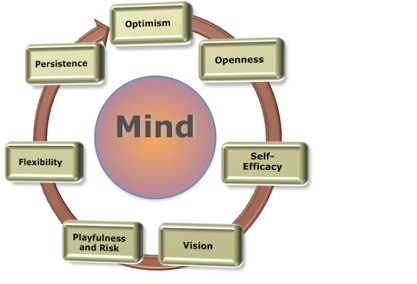Mind Steps


There are two fundamental and complimentary ways of achieving personal change: you can take action and you can change your mind. Taking action can change your mind and changing your mind facilitates action. Thus my model that I call Beyond Personal Mastery® involves 7 Action and 7 Mind steps.
The 7 mind steps that compliment and support the Action steps are: Optimism, Openness, Self-Efficacy, Vision, Playfulness, Flexibility, and Persistence.
Optimism. If you do not believe that some things can get better, you will have no reason to try wholeheartedly (unless you are lucky enough to have a mentor swinging a large croquet mallet in your direction). The idea of “Positive psychology” has been around at least since the 1950s and we are in the grip of it once more but don’t let that put you off. Aside from some of the overblown claims and simplicities, learning how to reframe your thinking into a positive cast of mind is a very useful skill.
Openness. The curse of clever people is that they too readily analyse new information and categorize it (i.e. dismiss it) into their existing schemas and frameworks. In this way they can be blind to nuances and nuggets that can change their lives. The curse of stupid people is that don’t bother analysing new information in the first place. The result in both cases is a kind of content and complacent maintenance of the status quo. The result is no movement, no change and no hope. Note this is not an invitation to fall for asinine schemes and behaviour. As Harold T. Stone said “I try to keep an open mind, but not so open that my brains fall out.”
Self-Efficacy. This is a concept pioneered by psychologist Albert Bandura and relates to one’s belief that you can do something or achieve something. People who believe they can successfully complete a training course or diet are more likely to do so than those without this self-belief. Self-efficacy is not just about positive self-talk (though this can help), but also about engaging in the action steps, to provide the proof to yourself that you really can do it. This is why the Emulating action step is so important. Once you can master a task you can go beyond mastery of it.
Vision. Vision has got a bad press because it has been over-used and devalued in numerous vision statements. However what I mean by vision is creating something akin to a mental movie in which you can see yourself doing whatever it is you are seeking to do. Can you see yourself acting and interacting with the other people in this desired domain? Do you feel comfortable, are you succeeding? The idea here is not a million miles away from imagery exercises that sports psychologists may use with sports folks, or indeed the way some musicians approach learning new instruments or pieces. The other point to make here, is that I am not advocating some form of visual goal-setting. The purpose of envisaging is to create some active engagement, that may lead to other opportunities as you act on the world.
Playfulness and Risk. Children will often test their toys to destruction, or use them in “inappropriate” ways. It means coming to an idea without pre-conceptions to see it for what it is. It is a bit like throwing away the instruction manual. The Zen Budhist term for this is Shoshin.
Flexibility. This is perhaps best summed-up by Groucho Marx’s quote “these are my principles and if you don’t like them, don’t worry I’ve got others”! It means most diamonds have flaws as well as brilliance, it depends how you hold it up to the light. The flexible mind will see the possibilities.
Persistence. I’ll bet the most important things you’ve done in your life have involved a degree of risk and have met resistance from some quarters. It is amazing how many people fail simply because they lose the courage of their convictions. Recognise that giving in is ultimately your choice and yours alone.

© Bright and Associates 2016
Beyond Personal Mastery® is a Registered Trademark of Bright and Associates